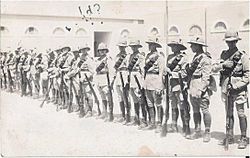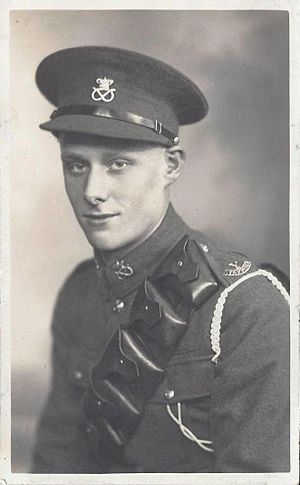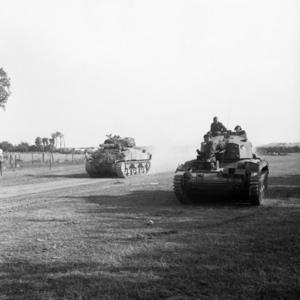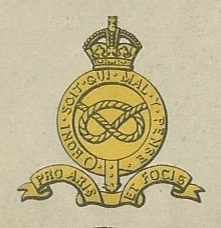Staffordshire Yeomanry facts for kids
Quick facts for kids Staffordshire Yeomanry |
|
|---|---|
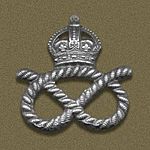
Badge of the Staffordshire Yeomanry
|
|
| Active | 1794–2021 |
| Country | |
| Branch | |
| Type | Yeomanry |
| Role | Cavalry/Armour |
| Size | 1–3 Regiments |
| Part of | Territorial Force Royal Armoured Corps |
| Engagements | Second Boer War World War I
|
| Battle honours | See battle honours below |
| Commanders | |
| Notable commanders |
George Leveson-Gower, 1st Duke of Sutherland Edward Monckton Thomas Anson, 1st Earl of Lichfield William Bagot, 3rd Baron Bagot Sir William Bromley-Davenport |
The Staffordshire Yeomanry (Queen's Own Royal Regiment) was a special part of the British Army. It was first created in 1794 to help protect Great Britain from invaders. Over the years, this group of soldiers changed a lot. They started out riding horses, then later learned to drive tanks! They served in many important wars, including the Second Boer War, World War I, and World War II. After World War II, the Staffordshire Yeomanry became part of a larger group called the Queen's Own Mercian Yeomanry. One of its squadrons kept the name 'Staffordshire Yeomanry' until 2021.
Contents
Early Days: Protecting Britain (1794–1814)
When Britain was fighting in the French Revolutionary Wars, the Prime Minister, William Pitt the Younger, had an idea. In 1794, he suggested that counties should form groups of volunteer cavalry called the Yeomanry. These groups would help protect the country from invasion. They would also help local leaders keep peace if there were problems.
Staffordshire was one of the first counties to create its own Yeomanry. The very first group, called the Stafford Troop, started on July 4, 1794. Soon, there were five groups across the county. They were all brought together to form the Staffordshire Regiment of Gentlemen and Yeomanry.
- Newcastle-under-Lyme group, led by Colonel Earl Gower
- Stafford group, led by Lieutenant-Colonel Edward Monckton
- Lichfield group, led by Major Francis Eliot
- Leek group, led by Captain James Bulkeley
- Walsall group, led by Captain William Tennant
The Staffordshire Yeomanry was first called into action in 1795. The Stafford Troop helped stop a riot where people were upset about bread prices. They managed to calm things down without anyone getting hurt.
In 1798, the threat of invasion grew. More local volunteer groups were formed in Staffordshire. These groups were similar to the Yeomanry, but they focused only on local defense. Some of these included the Loyal Pottery Volunteer Cavalry and the Loyal Walsall Light Dragoons.
After a short period of peace, war broke out again in 1803. Many volunteer groups reformed or new ones were created. The Staffordshire Yeomanry continued to train regularly. In 1810, the Bilston Troop helped local officials stop a riot at Wolverhampton Market. By 1814, the war ended, and some of the smaller troops disbanded. The Staffordshire Yeomanry had 428 men at this time.
Keeping the Peace in the 1800s
After the big wars with France ended, the Yeomanry became less important in many areas. But in industrial places like the Black Country and the Potteries, there was a lot of social unrest. Because of this, the Staffordshire Yeomanry was often called upon to help keep the peace.
For example, in 1815, they helped calm down rioting ironworkers and coal miners in Wolverhampton. The regiment grew to 12 troops with 838 men by the end of 1819. This made them a very large and important group.
- Stafford & Cheadle
- Lichfield
- Leek
- Walsall
- Weston
- Teddesley
- Bilston
- Tamworth
- Newcastle & Pottery
- Burton
- Uttoxeter & Blithfield
- Himley & Enville
A future Prime Minister, Robert Peel, even served as a lieutenant in the Uttoxeter Troop for a short time. Over the years, some troops were disbanded due to a lack of new members. In 1829, Colonel Monckton, who was 86, stepped down from leading the regiment.
Helping the Police
The Staffordshire Yeomanry was called out many times to help local authorities. They dealt with:
- Mining unrest and wage riots in places like Dudley, West Bromwich, and Wednesbury.
- Election riots in Newcastle-under-Lyme and Stafford.
- Miners' riots in the Potteries.
- Preventing looting in Tutbury.
- Helping during the Great Reform Act riots in Derby.
- Fighting fires in Walsall.
- Dealing with Chartist riots in the Potteries and Birmingham.
- More miners' riots in 1842, where some troops served for many days.
Becoming the Queen's Own Royal Yeomanry
In 1832, the regiment had a special duty: they escorted Princess Victoria (who would later become Queen Victoria) and her mother. They were visiting Thomas Anson, 1st Earl of Lichfield at Shugborough Hall.
After Princess Victoria became Queen, the regiment was given a special new name on February 12, 1838. They became the Queen's Own Royal Regiment of Staffordshire Yeomanry Cavalry. This was to remember the Queen's earlier visit.
By 1850, the regiment was the largest Yeomanry regiment in the country. It had 11 troops and 892 men! They were still led by the Earl of Lichfield. The regiment was called out again in 1855 to stop miners' riots in the Potteries. In 1867, they patrolled the streets of Wolverhampton during a meeting, but there was no trouble. This was the last time they were used to help the police.
Changes and Modernization
New rules for the Yeomanry came out in 1871. The Staffordshire Yeomanry was allowed to keep its 12 troops because it was so strong. They also received new, more modern rifles. In 1874, Lord Bagot retired and became the regiment's first honorary colonel.
By 1893, Yeomanry regiments were organized into permanent squadrons. The Staffordshire Yeomanry had four squadrons, each with different troops. They also had a band, ambulance, and signal sections. The regiment's main office moved to Lichfield.
In 1894, the Prince of Wales visited Lichfield to celebrate the regiment's 100th birthday.
Serving Overseas: The Imperial Yeomanry
The Second Boer War (1900–1902)
The Yeomanry was originally meant only for defense at home. But during the Second Boer War in South Africa, Britain needed more soldiers. So, in December 1899, a new rule allowed volunteer forces to serve overseas. Yeomanry regiments were asked to provide companies of about 115 men each for the Imperial Yeomanry. These soldiers would fight as Mounted infantry (MI), meaning they rode horses but fought on foot with rifles.
In January 1900, the Staffordshire Yeomanry quickly formed the 6th (Staffordshire) Company, IY. It was led by Captain William Bromley-Davenport. This company sailed to South Africa and became part of the 4th Battalion, IY.
The 6th Company saw tough service. They helped chase down Boer fighters and took part in many operations. Captain Bromley-Davenport was even promoted for his bravery. When the company finished its service in May 1901, many men had been wounded or fallen ill.
A second group, the 106th (Staffordshire) Company, was sent to South Africa to replace the first. These soldiers also took part in long treks and "drives" to capture Boers. The war ended in May 1902, and both companies returned home.
Because of their service in South Africa, the Staffordshire Yeomanry earned its first special honor: South Africa 1900–01.
After the war, the Yeomanry regiments at home were changed into Imperial Yeomanry. In May 1901, the regiment was renamed the Staffordshire Imperial Yeomanry (Queen's Own Royal Regiment).
World War I (1914–1918)
Getting Ready for War
In 1908, the Imperial Yeomanry became part of the new Territorial Force (TF). On April 1, 1908, the regiment was renamed the Staffordshire Yeomanry (Queen's Own Royal Regiment) (TF). Its main office moved to Stafford.
When World War I began on August 4, 1914, the Staffordshire Yeomanry got ready for war. They gathered in Stafford and then moved to Norfolk. At first, the TF was only meant for home defense. But soon, soldiers were asked to volunteer to serve overseas. Most men agreed.
This led to the creation of "2nd Line" units, which were copies of the original units. Later, "3rd Line" units were formed to train new soldiers.
Fighting in the Middle East: 1/1st Staffordshire Yeomanry
After training for over a year, the 1/1st Staffs Yeomanry sailed to the Mediterranean in October 1915. They ended up in Egypt and became part of the Egyptian Expeditionary Force (EEF). This force was fighting in the Sinai and Palestine campaign.
The regiment fought bravely in many important battles, including the three battles of Gaza and the Battle of Mughar Ridge. In November 1917, during the Battle of Nebi Samwil, the soldiers and their horses faced terrible conditions in the Judaean Hills.
In 1918, the 1/1st Staffs Yeomanry joined the Imperial Camel Brigade for operations in the Jordan Valley. Later, they became the only British unit in the 12th Cavalry Brigade, alongside two Indian cavalry regiments. They suffered many illnesses, especially malaria, in the hot Jordan Valley.
In September, the regiment took part in the Battle of Megiddo. They broke through enemy lines and rode 70 miles in 34 hours, capturing hundreds of prisoners. They then helped capture Deraa and Damascus on October 1. Since September 15, they had marched 233 miles and captured over 3,000 prisoners!
By the end of the campaign, the 1/1st Staffs Yeomanry was very tired and many men were sick with malaria. Hostilities ended on October 31, 1918. The regiment stayed in Egypt until December 1919.
Home Service: 2/1st and 3/1st Staffordshire Yeomanry
The 2/1st Staffordshire Yeomanry was formed in 1914 for home defense. In 1916, many Yeomanry units were changed into cyclists, and the regiment became part of the 3rd Cyclist Brigade. This meant they rode bicycles instead of horses.
Later in 1916, they were remounted (given horses again) and became part of the 2nd Mounted Brigade. But in August 1917, they became cyclists once more. They stayed in Kent until the war ended. The 2/1st Staffordshire Yeomanry began to disband in March 1919.
The 3rd Line regiment was formed in 1915. Its job was to train new soldiers and send them as replacements to the 1st and 2nd Line regiments. It was absorbed into another reserve cavalry regiment in 1917.
Between the World Wars
After World War I, there were too many cavalry units. A special group decided that only the 14 oldest Yeomanry regiments would stay as cavalry. The Staffordshire Yeomanry was the 5th oldest, so it kept its horses.
However, by the late 1930s, the plan was to give all cavalry units tanks and other vehicles. But the Yeomanry were not a top priority for new equipment. So, when World War II started, the Staffordshire Yeomanry still had horses.
Before World War II, the Staffs Yeomanry was part of the 6th Cavalry Brigade.
World War II (1939–1945)
The Staffordshire Yeomanry got ready for war on September 1, 1939. Their main office was in Wolverhampton. It was clear that horses wouldn't be useful in modern tank warfare. So, the 1st Cavalry Division, which included the Staffs Yeomanry, was sent to Mandatory Palestine for security duties. This freed up other troops for fighting.
Becoming a Tank Regiment in the Middle East
The 6th Cavalry Brigade arrived in Palestine in January 1940. They helped keep peace between different groups. The Staffordshire Yeomanry was chosen to become a tank regiment when tanks became available. On April 12, 1941, they officially became part of the Royal Armoured Corps.
In 1941, parts of the 1st Cavalry Division, including some of the Staffs Yeomanry, fought against French forces in the Syria–Lebanon campaign. The Staffs Yeomanry later received the honor 'Syria 1941'.
Back in Palestine, the change to tanks continued. In August 1941, their division became the 10th Armoured Division. In February 1942, the brigade moved to Egypt to train with tanks in the desert.
Fighting in the Western Desert
During the Battle of Gazala in June 1942, the 8th Armoured Brigade was sent to help the Eighth Army. But they had to give their tanks to more experienced units. They finally got new tanks and fought in the defensive Battle of Alam el Halfa on August 30. They then took part in the famous Second Battle of El Alamein (October 23–November 4) and chased the enemy afterward.
The 8th Armoured Brigade then joined the famous Desert Rats. They fought battles around El Agheila and chased the enemy all the way to Tripoli.
Battles in Tunisia
The regiment then fought in the Battle of the Mareth Line in Tunisia. They helped flank the enemy defenses and defeat a German counter-attack. They also fought at Wadi Akarit and Enfidaville, supporting New Zealand troops. Even though the land was too rough for their tanks to reach Tunis, the surrender of the Italian commander was arranged using the Staffs Yeomanry's command tank.
After Tunis fell, the 8th Armoured Brigade returned to Egypt. They were then chosen to go back to the UK to get ready for the invasion of Normandy.
D-Day and Normandy
On February 13, 1944, the regiment joined the 27th Armoured Brigade. This brigade was chosen to land on Sword Beach on D-Day (June 6) to help the 3rd Division. The Staffs Yeomanry used regular Sherman tanks and powerful Sherman Fireflies.
The Staffordshire Yeomanry started landing at 8:55 AM on D-Day. They were one of the first tank units to land. Their goal was to lead a mobile column to capture Caen. They faced strong defenses but got very close to Caen. They helped destroy German tank counter-attacks. The regiment then fought for weeks in Normandy, including in Operation Goodwood, where they had tough battles around Troarn.
The Scheldt and Crossing the Rhine
After heavy losses in Normandy, the Staffordshire Yeomanry went back to the UK to train on special DD tanks (Duplex Drive tanks). These tanks could float and move in water.
Their first action with these new tanks was during the Battle of the Scheldt. They helped the 52nd (Lowland) Division in an amphibious attack on South Beveland. The DD tanks made a big difference, even though the muddy banks were hard to climb.
For the crossing of the Rhine River on March 23, 1945 (Operation Plunder), the Staffs Yeomanry supported the 51st (Highland) Division. This time, special "carpets" were laid to help the DD tanks climb the steep, muddy riverbanks. The regiment fought hard around Rees for several days.
They were involved in an action at Lingen on April 15. Then, they used their DD tanks for the last river crossing of the campaign, at the River Elbe on April 29. The war in Europe ended just five days later, on May 4.
After the war, the regiment stayed in Germany for occupation duties. The Staffordshire Yeomanry officially stopped active service on March 1, 1946.
After the Wars (1947–2021)
When the Territorial Army was reformed in 1947, the regiment started up again as an armoured (tank) regiment. It had headquarters in Stafford and squadrons in Walsall, Stoke-on-Trent, and Burton-on-Trent.
In 1967, the regiment was reorganized and became an infantry unit (foot soldiers). It absorbed some other local army units.
In 1971, the Staffordshire Yeomanry became part of the Mercian Yeomanry, which was later renamed the Queen's Own Mercian Yeomanry. One of its squadrons was named B (Staffordshire Yeomanry) Squadron.
In 1999, this squadron joined with another to form A (Staffordshire, Warwickshire and Worcestershire Yeomanry) Squadron. This squadron became part of The Royal Mercian and Lancastrian Yeomanry.
In 2014, this squadron joined The Royal Yeomanry. However, in 2021, the squadron lost its connection to Staffordshire and was renamed B (Warwickshire and Worcestershire Yeomanry) Squadron.
Heritage and Traditions
Uniforms and Badges
Over the years, the Staffordshire Yeomanry wore many different uniforms. In the early days, they wore red jackets with yellow or white trim. They had special helmets with bearskin crests. Their badge was the Staffordshire knot, and their motto was Pro aris et focis (which means 'For hearth and home').
In 1808, they changed to blue jackets with white lace, like Hussar cavalry. Later, they wore Light Dragoon uniforms. When they became the 'Queen's Own' regiment in 1838, their uniform colors changed to red and blue, fitting for a 'Royal' regiment.
In 1850, they got new black metal helmets. By 1893, they wore a black Busby (a tall fur hat) with a red bag and a white plume.
During the Boer War, they wore standard khaki uniforms with a Slouch hat. They had a red patch on their hat with the Staffordshire knot badge. After the war, they adopted a khaki uniform with red cuffs and collars.
The simple Staffordshire knot badge was always important. From 1859, their buttons had the knot inside a circle that said 'THE QUEENS OWN ROYAL REGIMENT'. This design was used for officers' cap badges. From 1913, other soldiers wore a cap badge with the knot and a crown.
Special Honors and Memorials
The Stafford, Newcastle, and Lichfield Troops received special flags called standards in 1795. These yellow flags had the crowned Staffordshire knot and the motto.
In 1857, the regiment put up a memorial in Lichfield Cathedral to honor Lt-Col the Earl of Lichfield. He had served the regiment for over 40 years.
Today, there is a modern memorial plaque for the Staffordshire Yeomanry at the National Memorial Arboretum near Lichfield. It lists all the special honors the regiment earned in battle.
Battle Honours
The Staffordshire Yeomanry earned many special battle honors for their bravery. These honors are listed below (the ones in bold are displayed on their guidon, or flag):
| Second Boer War | South Africa 1900–01 |
| World War I | Egypt 1915–17, Gaza, El Mughar, Nebi Samwil, Megiddo, Sharon, Damascus, Palestine 1917–18 |
| World War II | Normandy Landing, Caen, Troarn, Rhine, Lingen, North-West Europe 1944–45, Syria 1941, Alam el Halfa, El Alamein, El Agheila, Advance on Tripoli, Tebaga Gap, Point 201 (Roman Wall), El Hamma, Akarit, Sebkret en Noual, Djebel el Telil, Enfidaville, Takrouna, North Africa 1942–43 |
Images for kids


